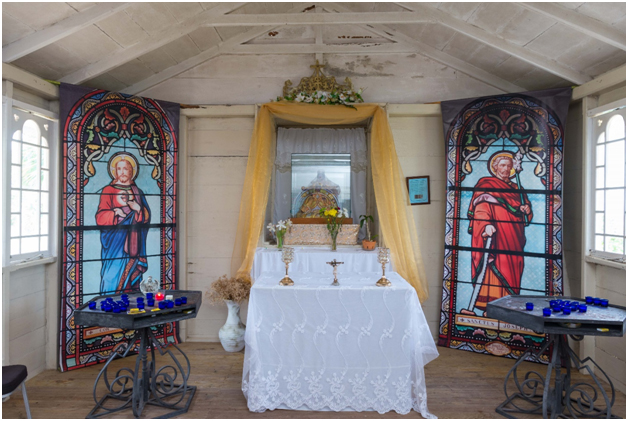 Photo courtesy Mr. Elmo Griffith
Photo courtesy Mr. Elmo Griffith
In Trinidad and Tobago, we do not possess a restoration culture nor do we typically engage in timely maintenance of our built heritage. Our church, Our Lady of Montserrat RC, was in a dilapidated state for many years before a team of parishioners and well-wishers embarked on its restoration between 2000 and 2004.
Sadly, many of our historic buildings are not well maintained and are in varying stages of disrepair. We find it difficult to restore them due to lack of will, funds or both. In the case of our church, a second restoration phase is being undertaken at this time in order to prevent further disrepair of the structure.
The situation is worse in parishes that are struggling financially. In an effort to save money or provide work for persons within the community, kind parishioners may offer their services. However, they may lack the appropriate restoration skills, resulting in the historic value of the structure being compromised.
Despite the efforts of groups like Citizens for Conservation and the National Trust, many of our citizens, including some in leadership positions, would prefer that a historic building be torn down rather than have it restored.
But what is meant by Restoration?
- Building restoration is about protecting the historic value of a structure.
- It is a process that accurately reveals, recovers or represents the state of a historic building as it appeared at a particular period in its history.
- In the restoration process, wherever possible, original materials are re-used, once they are in good condition. The wooden flooring in Our Lady’s Room in our church, for example, is the original flooring that was installed in 1878(see photo above).
- Where the original materials cannot be sourced, then either the oldest available material of a similar nature must be used or a material that is visually alike is acceptable. If, for example, guttering is required on our church to channel excess run-off, ideally galvanized guttering or aluminum should be used.
- Restoration must not be confused with remodelling, renovating nor with rehabilitation of a structure.
- Remodelling means “to change the structure or form of something” while renovation means to repair with no reference to or respect for the historic resource. With renovation, incompatible materials may be used along with changes to or removal of historic details. The result is a more modernised structure as there is no attempt to preserve history.
- Rehabilitation is defined as the act or process of making possible a compatible use for a property through repair, alterations and additions whilst preserving those portions or features that convey its historical, cultural or architectural values.
- In Trinidad and Tobago,“pure” restoration is rarely done. For example, the Cathedral of the Immaculate Conception in Port-of-Spain, has been restored and rehabilitated. Our church (Our Lady of Montserrat) was restored with minor elements of rehabilitation to accommodate contemporary worship and use and is therefore, a more historically accurate restoration of the building.
The Shrine Committee is working closely with the archdiocese of Port-of-Spain’s restoration team in this new restoration phase of the church. Please contact us ([email protected]) if you would like to make a donation towards this effort.
The Shrine Committee extends its heartfelt gratitude to Mrs. Rudylynn Roberts, Restoration Architect, for her invaluable guidance with this post.
